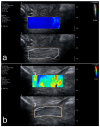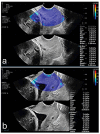The Emerging Role of Sonoelastography in Pregnancy: Applications in Assessing Maternal and Fetal Health
- PMID: 39795575
- PMCID: PMC11720552
- DOI: 10.3390/diagnostics15010047
The Emerging Role of Sonoelastography in Pregnancy: Applications in Assessing Maternal and Fetal Health
Abstract
Sonoelastography, a novel ultrasound-based technique, is emerging as a valuable tool in prenatal diagnostics by quantifying tissue elasticity and stiffness in vivo. This narrative review explores the application of sonoelastography in assessing maternal and fetal health, with a focus on cervical, placental, pelvic floor, and fetal tissue evaluations. In the cervix, sonoelastography aids in predicting preterm birth and assessing labor induction success. For the placenta, it provides insights into conditions like preeclampsia and intrauterine growth restriction through elasticity measurements. Assessing fetal tissues, including the lungs, liver, and brain, sonoelastography offers a non-invasive method for evaluating organ maturity and detecting developmental anomalies. Additionally, pelvic floor assessments enable better management of childbirth-related injuries and postpartum recovery. While current studies support its safety when used within established limits, further research is necessary to confirm long-term effects. Future advancements include refining protocols, integrating machine learning, and combining sonoelastography with other diagnostic methods to enhance its predictive power. Sonoelastography holds promise as an impactful adjunct to conventional ultrasound, providing quantitative insights that can improve maternal and fetal outcomes in prenatal care.
Keywords: cervical elasticity; fetal tissue assessment; maternal–fetal health; pelvic floor; placental stiffness; prenatal diagnosis; preterm birth prediction; shear wave elastography; sonoelastography; ultrasound imaging.
Conflict of interest statement
The author declares no conflicts of interest.
Figures




Similar articles
-
"Soft, hard, or just right?" Applications and limitations of axial-strain sonoelastography and shear-wave elastography in the assessment of tendon injuries.Skeletal Radiol. 2014 Jan;43(1):1-12. doi: 10.1007/s00256-013-1695-3. Epub 2013 Aug 8. Skeletal Radiol. 2014. PMID: 23925561 Review.
-
In vivo assessment of placental elasticity in intrauterine growth restriction by shear-wave elastography.Eur J Radiol. 2017 Dec;97:16-20. doi: 10.1016/j.ejrad.2017.10.007. Epub 2017 Oct 8. Eur J Radiol. 2017. PMID: 29153362
-
Cervical sonoelastography for improving prediction of preterm birth compared with cervical length measurement and fetal fibronectin test.J Perinat Med. 2015 Sep;43(5):531-6. doi: 10.1515/jpm-2014-0356. J Perinat Med. 2015. PMID: 25720038
-
Shear wave elastography in placental dysfunction: comparison of elasticity values in normal and preeclamptic pregnancies in the second trimester.J Ultrasound Med. 2015 Jan;34(1):151-9. doi: 10.7863/ultra.34.1.151. J Ultrasound Med. 2015. PMID: 25542951
-
Review of shear wave elastography in placental function evaluations.J Matern Fetal Neonatal Med. 2023 Dec;36(1):2203792. doi: 10.1080/14767058.2023.2203792. J Matern Fetal Neonatal Med. 2023. PMID: 37121902 Review.
Cited by
-
Bioinformatic Analysis of Apoptosis-Related Genes in Preeclampsia Using Public Transcriptomic and Single-Cell RNA Sequencing Datasets.J Inflamm Res. 2025 Apr 7;18:4785-4812. doi: 10.2147/JIR.S507660. eCollection 2025. J Inflamm Res. 2025. PMID: 40224388 Free PMC article.
-
Early Detection of Fetal Health Conditions Using Machine Learning for Classifying Imbalanced Cardiotocographic Data.Diagnostics (Basel). 2025 May 15;15(10):1250. doi: 10.3390/diagnostics15101250. Diagnostics (Basel). 2025. PMID: 40428243 Free PMC article.
References
-
- Okoror C.E.M., Arora S. Prenatal Diagnosis after High Chance Non-Invasive Prenatal Testing for Trisomies 21, 18 and 13, Chorionic Villus Sampling or Amniocentesis?—Experience at a District General Hospital in the United Kingdom. Eur. J. Obstet. Gynecol. Reprod. Biol. X. 2023;19:100211. doi: 10.1016/j.eurox.2023.100211. - DOI - PMC - PubMed
-
- Schrenk F., Uhrik P., Uhrikova Z. Ultrasound Elastography: Review of Techniques, Clinical Application, Technical Limitations, and Safety Considerations in Neonatology. Acta Med. Martiniana. 2020;20:72–79. doi: 10.2478/acm-2020-0009. - DOI
-
- Mottet N., Cochet C., Vidal C., Metz J.P., Aubry S., Bourtembourg A., Eckman-Lacroix A., Riethmuller D., Pazart L., Ramanah R. Feasibility of Two-Dimensional Ultrasound Shear Wave Elastography of Human Fetal Lungs and Liver: A Pilot Study. Diagn. Interv. Imaging. 2020;101:69–78. doi: 10.1016/j.diii.2019.08.002. - DOI - PubMed
Publication types
Grants and funding
LinkOut - more resources
Full Text Sources

